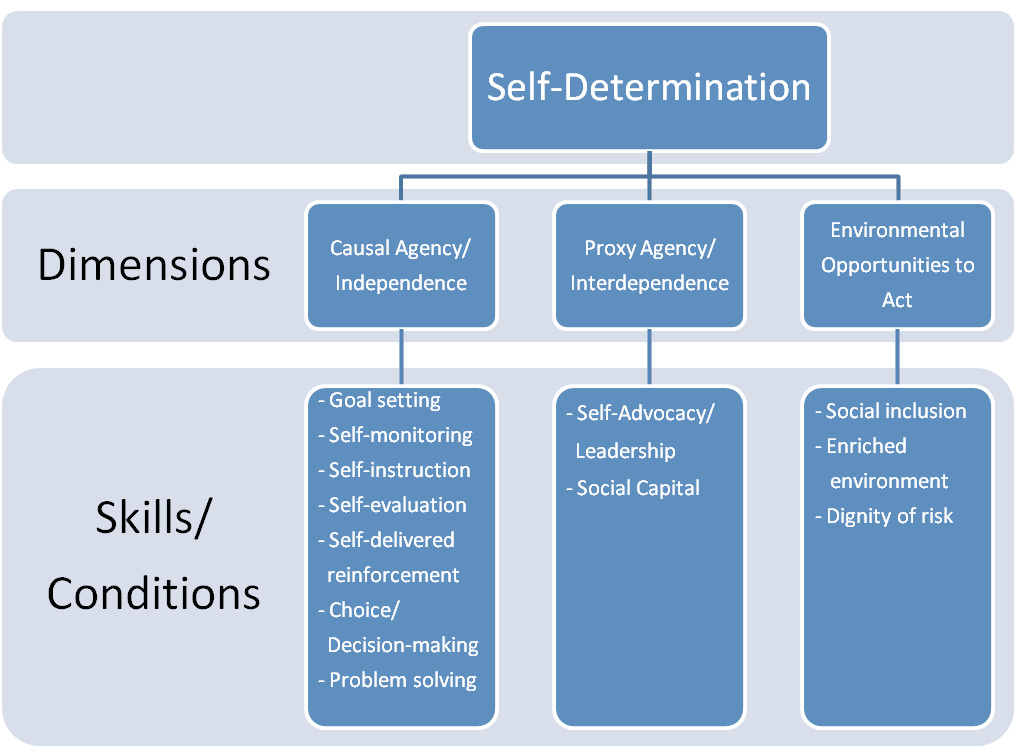When implementing programs for IWD it is important to seek their perspective on the types and levels of supports they need. However, often times IWD struggle to express their preferences and are not provided with opportunities to engage in activities to promote their self-determination. For educators of IWD, promotion of self-determination is foundational throughout the assessment, intervention, and monitoring process.
Promoting self-determination has become best practice in the education of IWD. Self-determination is a broad construct in which no single practice or package of practices applies. Based on work from Wehmeyer et al. (2011) and Walker et al. (2011), self-determination comprises three dimensions in which an individual needs to develop: (a) causal agency (an individual’s control of events), (b) proxy agency (provision of supports and assistance allowing the individual to control events), and (c) opportunities to act upon the environment. These dimensions and specific skills are displayed in Figure 1.3.1 below.

Figure \(\PageIndex{1}\): Framework of Self-determination Dimensions and Skills/Conditions
(from Loman et al., 2010)
Preference Assessments
During the assessment process, self-determination can be promoted through the use of preference assessments. Preference assessments include the student in identifying reinforcers as well as identifying meaningful activities and materials. Interviews of significant others regarding a student’s preferences are a good starting point. However, it is important to include the individual student in his or her own preference assessment. The use of direct observations of students interacting with different activities and materials is the most reliable way to obtain this information.
Several helpful resources for promoting self-determination are available through the Zarrow Center for Learning Enrichment at the University of Oklahoma (http://www.ou.edu/education/centers-and-partnerships/zarrow.html). The center provides preference-indicator tools for individuals of all ages:
- Child Preference indicators (www.ouhsc.edu/thecenter/products/documents/ChildPreferenceIndicators_rev1107.pdf),
- Personal Preference indicators (www.ouhsc.edu/thecenter/products/documents/CLLUCEDD_Personal_Preference_Indicators_June%202006.pdf), and
- Employment Support indicators (www.ouhsc.edu/thecenter/products/documents/EmploymentSupportIndicators.pdf).
These tools can assist IWD in identifying preferences and promoting their self-determination.
A systematic preference assessment involves the direct observation of an individual with different stimuli and observing their interactions with the materials or activities. Common methods for this are free-access preference assessments and forced-choice preference assessments. In a free-access preference assessment (shown below in Table 1.3.1), the assessor makes multiple materials or activities that may be preferred by the student readily available. The student’s interactions with the materials or activities are recorded to identify the most preferred items. See a sample template below:
Table 1.3.1: Free-Access Preference Assessment Template
| Student: |
Date Range of Sessions: |
| Complete the table below noting how long the student engages with the materials/activities during the session. |
| Date: |
Item 1: |
Item 2: |
Item 3: |
Item 4: |
Item 5: |
Item 6: |
| |
|
|
|
|
|
|
| |
|
|
|
|
|
|
| Total Time Engaged: |
|
|
|
|
|
|
A forced-choice preference assessment involves selecting a specific number of materials or activities and presenting them in pairs in a random fashion. At the conclusion of a forced-choice preference assessment, a hierarchy of preferred materials or activities is determined. An example of a forced-choice template is available at: http://r4strategiesasd.wikispaces.com/file/view/Forced+Choice+Reinf+Assessment.pdf
Self-determination practices
Five practices identified as having evidence for promoting self-determination for IWD (Loman, Vatland, Strickland-Cohen, Horner, & Walker, 2010; Vatland et al., 2011) were: (a) use person-centered planning methods; (b) use teacher-directed instructional strategies; (c) teach students skills needed to self-direct learning; (d) create and maintain a system that involves family supports and family involvement; and (e) organize environments to provide enriched opportunities, supports, models, and resources. In their practice guide, Loman et al. (2010) provide a definition of the practice, level of evidence and social validity, a brief summary of support for the practice, instructions for how to implement the practice, and identified barriers or limitations of the practice.
The promotion of self-determination is critical to the development of an effective and meaningful program for IWD. The practices and procedures presented within this chapter and the remainder of this text should be framed with promoting self-determination in mind.



